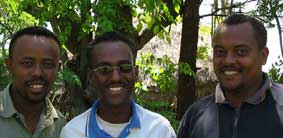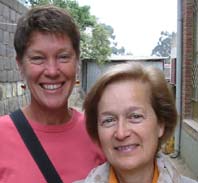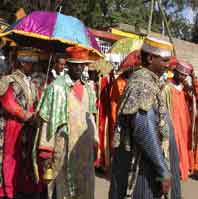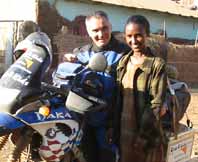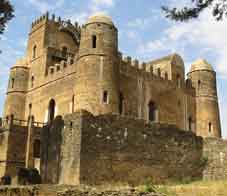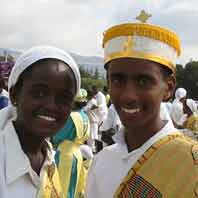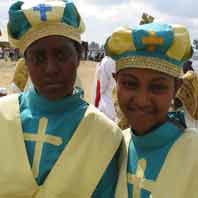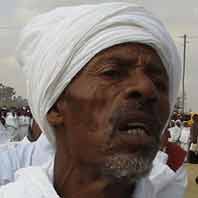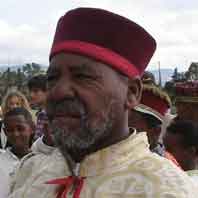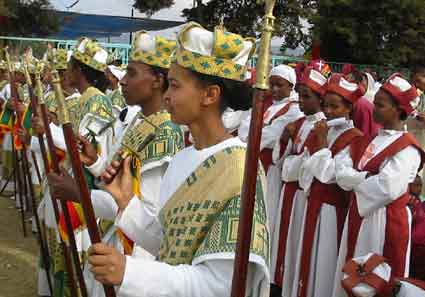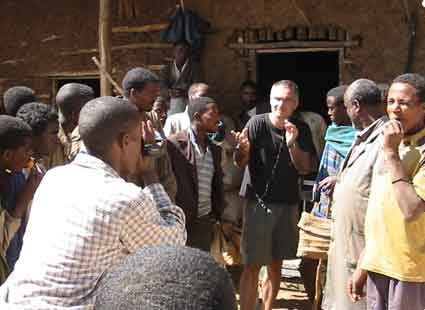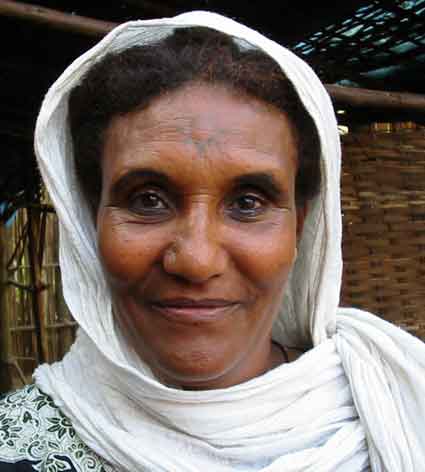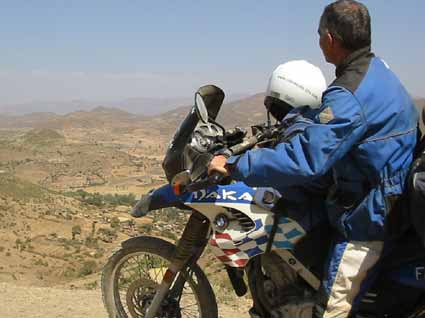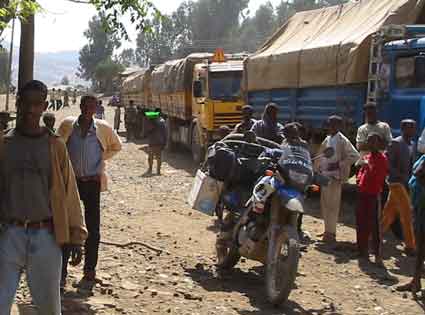"Will you marry
my daughter?"
Friday
10th Jan.
I had been waiting a week now, in Awassa, for the world Vision staff to return
to work after the Christmas holiday so that morning I went straight there to
see if they were back and they were. I met Abebe Assefa, Berhanu Gezu and Lemma
Tamiru (pictured) and
together
we went to visit the Humbo Area Development Program some 120 km northwest of
Awassa.
This program was started in response to the 1984/85 drought as relief assistance
for drought affected population of the area and moved to rehabilitation and
development in the following years. The total population is estimated to be
135,000 inhabitants.
Humbo ADP has made remarkable effort in the following interventions.
- Irrigation development.
- Support live stock production.
- Increase household off-farm income.
- Improve household health status.
- Improve household access to basic education.
One of the big problems was the Tse-Tse fly which was destroying the live stock.
Through the integration of efforts among the stockholders, significant number
of cattle population has benefited from Tse-Tse flies control campaign.
The highlight of my visit was definitely the Likimse Abela water supply and
sanitation project. It was started in December 1999 and completed in September
2001. It was entirely financed by AUSAID and World Vision, costing 800,000 thousand
US$. Two reservoirs of 300,000 litres each were build as well as 28 water points.
The direct impact was,
- Easy access to potable water.
- Plenty water for cattle.
- Communities' health and sanitation improved.
- Time and distance traveled in search of water reduced tremendously.
- Because of abundance of water farmers began cultivating vegetable and fruit
trees even in dry times.
- Households are able to efficiently use their time and labour they used to
spend in search of water for other more productive activities.
- Women workload minimized.
- School children have more time for their studies.
- Many who had fled their home villages in the lowland for various reasons have
now begun returning to their original villages.
As well as the Likimse water supply we visited
new built schools, dispensaries and waterholes. As usual, the locals were
most friendly and could not thank enough the Australian people for the difference
they have made to their life.
We returned to Awassa the next day. I have to say a big thank you to the staff
of World Vision Humbo who went to the trouble of cooking special food for
my very delicate stomach and for making my visit so enjoyable
Sunday
12 Jan. 2003
I left Awassa at 9am, the road is in very good condition, but it got very windy,
the lavish green scenery became a very dry and hostile desert, very sandy. I
could see a lot of farmers taking their herds to some water points, mostly small
lakes.
I
reached Addis Ababa early in the afternoon, only 265km from Awassa, and went
straight to my friends Yolande Armstrong and Cecilia Arrigoni (pictured). I
had met them earlier on in Arba Minch and they had kindly invited me to stay
with them while in Addis. They both work for a British organization called VSO
(voluntary services oversea) in the Ministry of Education.
Addis Ababa, the capital, has a population of 3 million inhabitants; it is noisy,
dusty, sprawling and shambolic. In Amharic it means "New Flower" I
can assure you that it
certainly
is not.
The next day I went to the Sudan embassy to organize my visa for Sudan and was
told to come back in a couple of days to fetch it. I was a little worried about
that particular visa as they don't always grant you one but I seemed to be lucky
this time.
I also payed a visit to the National World Vision office and was welcomed by
Tilahun Maresha. He organized for me to visit another WV project for the next
day.
We drove there the next morning. This project is in the Adama region and is
located at 118km southeast of Addis Ababa. It was started in 1990 and should
be completed in 2005.
Major accomplishments so far are,
AGRICULTURAL DEVELOPMENT
- Developed 200 ha small scale irrigation schemes on two sites belonging to
365 households.
- One veterinary clinic constructed.
- 4 veterinary posts constructed.
- 12,053 farmers and government staff provided with training and workshop.
ENVIRONMENTAL REHABILITATION
- 9, 3 million seedlings planted.
- 14,900 km of soil and water conservation structures constructed.
- 759 km feeder road constructed.
- 3,257 farmers trained in environmental protection.
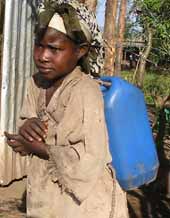
HEALTH
- 2 clinics constructed.
- 6 health posts constructed.
- Training and material support provided.
- 56,490 people got medical attention.
- 80,741 people attended health education.
- 13,454 mothers and children immunized.
- 15 bore-holes drilled.
- 30 km pipe extended from spring.
.
EDUCATION
- 6 elementary, junior secondary and high schools constructed and upgraded.
- Training and education material support provided.
As you can see all your money is well spent
and does make a big difference. I was able to see most of those projects and
I am happy to report that in the near future all the people from Adama will
be able to sustain themselves on their own.
Thank you to Yeshinegus Adamseged, the manager of the project, for taking
the time to show me around.
While
in Addis I was also lucky to witness the Timkat festival (Epiphany, celebrating
Christ's baptism), held every year on the 19th of January. It is one of the
most colourful festivals of the year. The church tabots (replicas of the Ark
of the Covenant) are taken to a nearby body of water on the afternoon of the
eve of Timkat. During the night, the priests and faithful participate in a kind
of vigil around the tabots. The following morning, the crowds gather around
the water, which is blessed, them splashed onto them; religious vows are renewed.
The tabot is then paraded back to the church accompanied by much singing and
dancing.
Even
though Addis is not supposed to be the best place to see this event, I thought
it was pretty spectacular all the same.
Tuesday
21 Jan.
After a week in Addis Ababa it was time for me to hit the road again but before
I leave I just want to say thank you so much to Yolande and Cecilia for their
kindness and generosity, thanks to you guys I had a most enjoyable time in this
city.
I left the house at 8.30 in the morning, had a little trouble finding my way
out especially at that time, everyone is going to work, the traffic was very
heavy. I travelled for one hour until I realized that I was on the wrong road,
I had to ride all the way back to Addis.
The road was perfect for the first 100 km, nice tarmac, and then I reached the
most dramatic stretchers of road in Ethiopia if not in Africa. Dropping over
1000m the road gradually winds down the escarpment to the bottom of the Blue
Nile George and then up again. The road is very rough, not sealed. Trucks and
buses travel very slowly (no more than 20km/h) due to the bad condition of the
road and also worrying about brake failure. I was able to ride faster but had
the problem to overtake them which was not easy as I could not see anything
with the amount of dust that they were leaving behind them. It took me one and
half hour to get to the other side of the canyon but what a scenery!
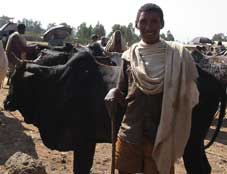
Along
the way I could see a lot of shepherds in their delightful reed (raincoats),
Amhara women in their pleated highland skirts, and men carrying their indispensable
dula. The dula is the chosen travelling companion of almost every Amhara man.
A kind of hardwood staff, measuring about 1m, it serves a variety of purposes.
It is used to carry loads to and from market, to brace the shoulders on long
treks, to lean on during the never-ending church services, and to defend oneself
on times of need.
I
reached Debre Markos at 3 pm and decided to call it a day, I had covered 335
km. I stayed in a very basic hotel, without showers.
The next morning, I was on the road at 7am, the road was brand new for 70 km,
it is currently been built by the Chinese but I think it will take another 5
years to be completed. It took me 2 hours to cover the next 25 km as there were
not really any kind of road, just a mass of trucks, machinery, dust and rocks.
I fell twice, just loosing balance, likely there were enough people to help
me to pick up the bike.
The next 170 km were on an unsealed road to Bahar Dar, my next stop. I reached
it at 2 pm, covered in dust and exhausted but glad to have made it. I get very
sore arms when I ride on bad roads so I decided to stay here for a couple of
days to recover.
Bahar Dar is probably one of Ethiopia most attractive towns. It has wide avenues
of palms and flamboyant trees and is located on the shore of Lake Tana. Unfortunately,
the harassment from the locals makes it not so pleasant. The constant "you!
You! Give me money, pens or birr" can drive you crazy. Children scream
at you "mother and father dead, give me money!"
This is also the place where the Blue Nile begins, running all the way to Khartoum
to meet with the White Nile coming from Uganda and together form what we know
as the Nile, which keeps going to the Mediterranean Sea.
The following day I took a local bus to the Blue Nile falls, only 32 km from
bahar Dar. When in full flood, it is impressive for its incredible width (400m)
as for its depth (45m). Right now it's the dry season so there is not that much
water, the best time is immediately after the rainy season (from mid-September
to mid-October). Nevertheless, the walk around the countryside was worthwhile
anyway.
One day, as I was walking around town, a young girl started to talk to me in
broken English. After the initial introductions she begged me to come to her
family house for a coffee ceremony. The last one still fresh in my memory, I
accepted under the condition that it would be only coffee and no food whatsoever.
We arranged to meet later on that afternoon and walked to her place. I had bypass
lunch just in case food appeared. I was met by the whole family and the ceremony
began, of course I had to eat some food but as I was prepared it was not a problem
this time. Everything was going fine until I nearly chocked on my injera when
suddenly the father said.
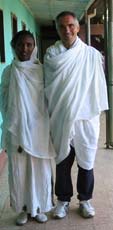
-"I
would like you to marry my daughter and take her with you to Australia."
I looked at him and I knew right away that he was deadly serious. What was I
supposed to say? After all the food and the ceremony, I could not just say no
way, I had to be a bit more sensitive, more polite, respectful even. But I could
not think of anything to say so I just pretended that it was funny and started
to laugh, saying that I had unfortunately no room on the bike and that my girlfriend
would not be very pleased if I brought a new wife at home. That did defuse the
tension and soon everyone started to laugh as well, more coffee was served and
the idea of marriage was never brought up again. During the following few days
we become best friends, they took me to church, on a boat trip across the lake
to visit a small village and invited me to more coffee ceremony. This is why
my couple of days in Bahar Dar turned up
to
be a full week of very interesting new experiences. In case you are wondering,
that young girl was only 22 years old; even though I am only 39 (in Ethiopia)
it's still a big gap.
Tuesday
28 Jan.
After a quick goodbye to the future bride (pictured) it was time to get back
on the road again. I was only 180 km from Gonder, the last major town in Ethiopia
before entering Sudan. The road was very rough but very picturesque nevertheless,
as usual plenty of dust, stones and slow trucks along the way. I reached Gonder
early in the afternoon, found a cheap hotel and started exploring this town.
Gonder has been called African's Camelot, and with its series of castles and
churches is
one
of the major attractions of the historical route. I visited the Royal Enclosure
with its most impressive castle (pictured). The castle was built by Emperor
Fasilidas around 1640. There are other sites around the Enclosure including
another castle, the Bath of Fasilidas and a church. I usually don't have much
time for old monuments or historic sites but I really did enjoy this one.
Thursday
30 Jan.
The Sudanese border was 200 km away, I left early as I wanted to rich Gedaref
before night time, Gedaref is the first
major
town in Sudan. The road was a bit rough but not as bad as before Gonder, so
I was able to reach the border at 11 am with plenty of time in hand to cross
the border. As it turned up it took quite a bit more than I had expected but
you will have to wait until the next update to found out why.
Did I like Ethiopia? Even though it is a very demanding country to visit due
to the constant harassment, it's still a very fascinating country, so different
from anyway else. I did like it very much and it is my favourite country in
Africa so far and I think that it will be hard to beat. So do yourself a favour,
as Molly would say, and visit it before everyone else does. More
photos.
Vendredi
10 Janvier 2003.
Je dois d'abord remercier Sylvie, ma belle soeur, pour m'avoir envoyer un dictionnaire
Français, donc s'il y a des fautes d'hortographe ce n'est pas de ma faute
mais celle du dictionnaire.
Comme les vacances de Noel était fini pour les Ethiopiens, les employés
de World Vision avaient repris le travail. Je suis allé avec eux visiter
le projet de Humbo, à une centaine de km d'Awassa. Nous y avons passés
deux jours, en visitant different projets.
Le Likimse water projet a été construit par le gouvernement Australien
et aussi par tout les Australiens qui sponsorent les enfants de la région.
Le projet a couté 800,000 dollars Americain et apporte de l'eau potable
à plus de 135,000 personnes habitant la région. Cela a permis
au gens de cultiver régulièrement, aux enfants d'aller plus souvent
à l'école car ils n'ont plus besoin de marcher pendant des heures
pour aller chercher de l'eau et aussi, bien sur, a amélioré leurs
hygiènes.
Il y a beaucoup de mouche Tzé Tzé dansLa région, celles-ci
détruissaient les troupeaux. Depuis cinq ans, World Vision a intervenu
et a pu métriser ce fléau, donc maintenant les fermiers peuvent
utiliser les boeufs pour cultiver la terre et aussi pour produire du lait.
C'est trés intéressant de voir la différence que votre
argent fait à la vie quotidienne dans ces pays.
Dimanche 12 Janvier.
J'ai repris la route en direction d'Addis Ababa, 300 km plus loin. Le paysage
tropical du sud a fait place au désert, terrain sableux, inhospitalier
et sec. Le vent soufflait fort, emportant le sable avec lui, ce qui rendait
la conduite difficile.
Je suis arrivé à Addis vers une heure de l'aprés midi
et je suis allé directement chez Yolande Armstrong et Cecilia Arrigoni.
Je les avais rencontré à Arba Minch quelques jours avant et
Ils m'avaient généreusement invités chez eux pour mon
séjour à Addis, donc j'en ai profité. Yolande et Cécilia
sont en Ethiopie pour 2 ans et travaillent comme semis volontaires pour le
ministère de l'éducation.
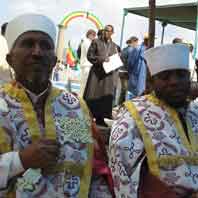
Addis Ababa est une ville bruyante, poussièreuse
et chaotique. En Amharic, Addis Ababa veut dire " nouvelle fleur "
je peus vous assurer que c'est loin d'être une fleur.
Pendant mon séjour j'ai organisé mon visa pour le Soudan, visité
la ville et j'ai aussi eu la chance d'assister au festival de Timkat. C'est
un festival religieux pour les chrétiens hortodoxe, trés colorés
qui dure deux jours.
Mardi
21 Janvier.
Aprés une semaine à Addis il était tant pour moi de faire
mes adieux à Yolande et Cécilia, merci beaucoup mesdames pour
votre
hospitalitée et de votre gentillesse.
J'ai eu quelques difficultées à sortir de la ville car à
huit heures du matin c'est l'heure de pointe, en plus il n'y a aucun panneau
donc difficile pour trouver la bonne route, j'ai donc tourné en rond
pendant un bon moment. Une fois sur la bonne route les choses ceux sont améliorées
trés rapidement. La route est toute neuve pendant les premiers 100 km,
puis elle s'arrête brusquement à l'entrer des Gorges du Nile Bleu
et descend de 1000m sur un chemin caillouteux. Le paysage est superbe mais la
route trés dangereuse, comme d'habitude ce sont les camions et les cars
qui créent des problèmes car ils sont trés lent et trés
difficile à dépasser, laissant des montagnes de poussière
derrière eux. Cela m'a pris une heure et demie pour traverser ce passage
difficile, une fois en haut j'ai retrouvé une route goudronnée
mais pas en bonne condition. Je suis arrivé à Débre Markos
vers quatre de l'apré-midi et decidais d'y passer la nuit. Un hotel plutot
minable m'assurait un toit pour la nuit.
Je repartais à 7 heures le lendemain matin, tout frais aprés une
bonne nuit mais toujours aussi poussiéreux faute d'eau pour me laver.
Une heure plutard la route se dégradait de plus belle, faisant place
à une masse de machines, camions et de tonnes de poussière. Pendant
vingt km je zigzaguais entre tout ça car ils étaient là
pour réparer la route, je suis tombé deux fois sans gravité
à cause de perte d'équilibre et de vision. Petit à petit
la route c'est amélioré et j'arrivais à Bahar Dar vers
trois heures et demie, ayant parcouru 300km. Couvert de poussière et
fatigué, je décidais de rester içi pour deux jours.
Bahar Dar est une petite ville ville sur le bord du lac Tana. Bien qu'elle soit
assez agréable, les habitants la rendent pénible avec leurs harcèlements.
Les enfants, qui probablement ne comprennent pas ce qu'ils disent, nous harassent
en nous disant " papa et maman sont morts, donnes nous de l'argent ! "
C'est trés fatiguant et énervant.
C'est aussi içi que le Nile Bleu prend sa source et continue jusqu'à
Khartoum ou il rejoint le Nile blanc venant de l'Uganda, ensemble, ils coulent
vers l'Egypte pour se jetter dans la méditerranée.(attention les
enfants !, j'espère que vous prenez des notes car je vous poserai des
questions lors de ma visite).
J'en ai aussi profité pour aller voir les chutes (cascades) du Nile bleu
à une trentaine de km de bahar Dar. Ceux sont les deuxièmes plus
importante chutes en Afrique, malheureuresement, comme c'est la saison sèche
il n'y avait pas beaucoup d'eau mais la promenade en vallait quand mème
la peine.
Un jour, alors que je me promenais gentiment dans le village, une jeune Ethiopienne,
jolie et guère plus de vingt ans, m'a abordée et m'a adressée
la parole dans un anglais loin d'être parfait mais compréhensible
quand-mème. Aprés les questions habituelles, elle me prie de venir
chez- elle, dans la soirée, pour célébrer la cérémonie
du café avec sa famille. Aprés l'épisode de la dernière
fois j'hésitais un peu mais acceptais quand-mème.
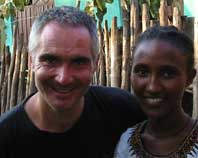
Elle
m'avait donnée rendez-vous à cinq heures à mon hotel pour
m'accompagner jusqu'à chez-elle. Pas de problème, elle était
mème en avance. Elle habitait avec ces parents dans une maison en terre
qu'on ne peut plus modeste. Bien que j'avais insisté que je venais que
pour prendre le café et surtout rien à manger, je me méfiais
un peu et ne mangeais rien du tout dans l'aprés-midi, comme ça,
en cas de coup dur, je serai prêt. Tout la famille m'attendait et on s'installait
tous autour du feu de bois ou la jeune demoiselle préparait la cérémonie.
Comme je l'avais prévu et
malgré
mes protestes, ils m'apportaient à manger. Mauvais moment à passer
je me dis et commence à manger le repas typique Ethiopien. C'est à
ce moment là que le père se lève et me dit :
" Allez vous marier ma fille et l'emporter avec vous en Australie ? "
Je me demande si j'ai bien compris et je m'aperçois vite qu'il est sérieux.
Que répondre à une question pareille ?, toute la famille a les
yeux sur moi, surtout la future mariée. Pas question de blesser cette
famille, surtout aprés un accueil pareil, je dois trouver une excuse,
montrer du respect et de la sensibilitée J'ai beau cherché, rien,
le vide total dans ma tête. Alors je prétend que c'est une plaisanterie,
je ris en disant que malheureusement je n'ai pas de place sur la moto et aussi
que si je reviens avec une femme en australie que dira ma copine Sussan. Cela
semble détendre la tension et bientôt tout le monde rit avec moi,
sauf la promise bien sur. On boit un autre café, puis un autre et la
question de mariage n'est plus remise sur le tapis. Ouff !!!
Pendant les jours suivant nous sommes devenus de bons amis, ils m'emmenèrent
à la messe, en bateau sur le lac et bien entendu à d'autres cérémonies
de café.
C'est pour ça que mes deux jours de repos sont devenus une semaine de
culture Ethiopienne. Ah ! les femmes ! Je dois dire que quelques part quand-mème,
j'etais flatté, à 46 ans, d'avoir une proposition de mariage c'est
rare, surtout avec une jeune fille de 22 ans.
Mardi 28 Janvier.
Aprés avoir fait mes adieux à la future mariée, j'ai repris
la route, le coeur et l'esprit en pleine forme, vers Gonder,180km plus loin
et dernière ville avant la frontière du Soudan. La route était
toujours aussi mauvaise mais sans trop de problèmes, j'arrivais à
Gonder à une heure de l'aprés-midi.
Je n'ai pas manqué de visiter le Palace de Fasilidas, le plus impressionnant
de la région et qui fut constuit en 1640 et aussi quelques autres sites.
Deux jours plus tard je reprenais la route pour la frontière soudannese,
seulemenent à 200km de Gonder et toujours sur une route plus ou moins
rocailleuse. J'atteingnais la frontière à 11 heures et avais confiance
de la traverser en une heure, voir moins. Les événements en decidèrent
autrement. Ne manquez pas la suite, bientôt sur votre ordinateur et dans
le confort de votre maison.
Brièvement, est-ce-que j'ai aimé l'Ethiopie ? Oui, bien que ce
soit un pays fatiguant à visiter, il reste quand mème un pays
trés interréssant, fascinant, surprenant, émouvant et attachant.
J'en garderai de trés beaux souvenirs, beaucoup d'images fortes et de
rencontres inoubliables. J'ai passé cinq semaines dans ce pays et je
le quitte avec la george serrée.

faces at the Timkat festival.
Visages du festival de Timkat.
Girls at the Timkat festival.
Les jolies filles au festival de Timkat.
Working on my documentary.
Interview pour mon documentaire.
The mother of the bride.
La mère de la mariée.
Admiring the scenery in Ethiopia.
Paysage d'Ethiopie.
Having a break from the hard
road.
Un moment de repos.
 |
 |
 |
 |
 |
 |
 |
 |
 |
 |
 |
 |
 |
|
JOURNAL 13 second
part of Ethiopia.
01/02/03 . Ethiopia . Total
mileage so far 17,700km .
(Pour la version française
du journal, allez au bas de la page ou cliquez
içi.
Pour revenir à la version française du site, cliquez
sur Français)
How
can you help make Ride4Kids a worthwhile project? To find out,
click here.
|
|
